What'sNEW Archives, April-June 2002
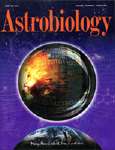 June 6:
Two New Astrobiology Journals —
June 6:
Two New Astrobiology Journals —
Astrobiology, first published in Spring 2001, covers "meteoritics, cosmochemistry, gravitational biology, planetary geology and habitability, exobiology, microbial paleobiology, ecogeology, origins of life, bioastronomy, and life detection and space exploration technology."
 Astrobiology, ISSN: 1531-1074, Published Quarterly in print and online by Mary Ann Liebert, Inc. Astrobiology, ISSN: 1531-1074, Published Quarterly in print and online by Mary Ann Liebert, Inc.
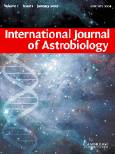
International Journal of Astrobiology "aims to become a major forum for the study of astrobiology and will publish peer-reviewed research papers, review articles, book reviews and news of interest to the astrobiology community. Subjects covered will include cosmic prebiotic chemistry, planetary evolution, search for planetary systems and habitable zones, origins, evolution and distribution of life, extremophile biology and experimental simulation of extraterrestrial environments, life detection in our solar system and beyond, technologies and space missions for astrobiology and planetary protection, human expansion, ecosystems and life support beyond Earth, and intelligent life and societal aspects of astrobiology. [Thanks, Larry Klaes.]
 International Journal of Astrobiology, Cambridge University Press. International Journal of Astrobiology, Cambridge University Press.
 Introduction is the related CA webpage. Introduction is the related CA webpage.
May 30: More signs of subsurface ice — patterned ground on Mars resembles the polygonal cracks on Earth that are caused by repeated freeze-thaw cycles.
 Southern Hemisphere Polygonal Patterned Ground, Malin Space Science Systems, 29 May 2002. Southern Hemisphere Polygonal Patterned Ground, Malin Space Science Systems, 29 May 2002.
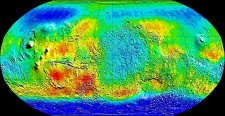 May 29:
May 29: Lots of water on Mars! The Gamma Ray Spectrometer that has been mapping Mars since February 2002 has detected signs that the upper three feet of soil in a large region surrounding the Red Planet's south pole is more than 50 percent water ice by volume. The signature is also seen in the north, but not in the areas close to the pole. These areas are shown in blue on the accompanying image. [Thanks, Francisco Carrapico, Ron Baalke and others.]
 Dirty Ice on Mars, by G. Jeffrey Taylor, Hawai'i Institute of Geophysics and Planetology, 5 June 2002. Dirty Ice on Mars, by G. Jeffrey Taylor, Hawai'i Institute of Geophysics and Planetology, 5 June 2002.
 Odyssey Finds Water Ice in Abundance Under Mars' Surface, JPL, NASA, 28 May 2002. Odyssey Finds Water Ice in Abundance Under Mars' Surface, JPL, NASA, 28 May 2002.
 Found it! Ice on Mars, Science@NASA, 28 May 2002. Found it! Ice on Mars, Science@NASA, 28 May 2002.
 Mars Odyssey quenches researchers' thirst for water data, Los Alamos National Laboratory, [publicised] 29 May 2002. Mars Odyssey quenches researchers' thirst for water data, Los Alamos National Laboratory, [publicised] 29 May 2002.
 Life on Mars! is the related CA webpage. Life on Mars! is the related CA webpage.
 May 27:
May 27: A new amino acid has been discovered by two teams of researchers at Ohio State University. "For 30 years after the ...unraveling of the genetic code, scientists believed that there were only 20 natural amino acids. Then in 1986,... the 21st had been discovered. Finding a 22nd suggests that even more of these basic biological building blocks may be found using modern genome sequencing techniques." [Thanks, Marsbugs.]
 Gayathri Srinivasan, Carey M. James, and Joseph A. Krzycki, "Pyrrolysine Encoded by UAG in Archaea: Charging of a UAG-Decoding Specialized tRNA" [abstract], p 1459-1462 v 296 Science, 24 May 2002. Gayathri Srinivasan, Carey M. James, and Joseph A. Krzycki, "Pyrrolysine Encoded by UAG in Archaea: Charging of a UAG-Decoding Specialized tRNA" [abstract], p 1459-1462 v 296 Science, 24 May 2002.
 Bing Hao, Weimin Gong, Tsuneo K. Ferguson, Carey M. James, Joseph A. Krzycki, and Michael K. Chan, "A New UAG-Encoded Residue in the Structure of a Methanogen Methyltransferase" [abstract], p 1462-1466 v 296 Science, 24 May 2002. Bing Hao, Weimin Gong, Tsuneo K. Ferguson, Carey M. James, Joseph A. Krzycki, and Michael K. Chan, "A New UAG-Encoded Residue in the Structure of a Methanogen Methyltransferase" [abstract], p 1462-1466 v 296 Science, 24 May 2002.
 New Amino Acid Discovered..., Ohio State Research News, 23 May 2002. New Amino Acid Discovered..., Ohio State Research News, 23 May 2002.
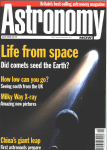 May 19:
May 19: "Life from space: Did comets seed the Earth?" is the cover caption of Astronomy Now, Britain's best-selling astronomy magazine. In a Focus section, "Carbon's legacy," articles include "The carbon drenched universe," "The stuff of life," and "The long road to panspermia." The last one, by Chandra Wickramasinghe, includes mention of the recent balloon experiments and a new photo of the late Sir Fred Hoyle.
 Chandra Wickramasinghe, "The long road to panspermia," p 57-60 v 16 n 4 Astronomy Now, April 2002. Chandra Wickramasinghe, "The long road to panspermia," p 57-60 v 16 n 4 Astronomy Now, April 2002.
 Chandra Wickramasinghe is a related CA webpage. Chandra Wickramasinghe is a related CA webpage.
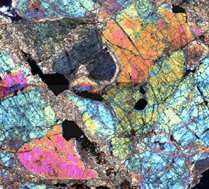 May 14:
May 14: Magnetites in Mars meteorite nonbiological? Planetary scientist Edward R. D. Scott and mineralogist David J. Barber have examined magnetites in ALH84001 and report that they are nonbiological. Their observations include, "The whisker-shaped magnetites exhibited epitaxy. An epitaxial relationship indicates abiogenic growth in or on the carbonate." And they report, "Many but not all magnetites are oriented with their close-packed layers of oxygen atoms aligned with those in the carbonate, consistent with what we observed for periclase. This demonstrates that the embedded magnetite crystals formed within the carbonate crystal by diffusion of atoms and loss of carbon dioxide." By our reading of their web report, the issue is not closed, as their tone implies. The team that originally analyzed the meteorite at NASA's Johnson Space Center did not claim that all of the magnetites are biological. We hope the NASA team will reply soon to this rebuttal. [Thanks, Ron Baalke.]
 Edward R. D. Scott and David J. Barber, "Origin of supposedly biogenic magnetite in the Martian meteorite Allan Hills 84001" [abstract], p 6556-6561 v 99 Proc. Natl. Acad. Sci. USA, 14 May 2002. Edward R. D. Scott and David J. Barber, "Origin of supposedly biogenic magnetite in the Martian meteorite Allan Hills 84001" [abstract], p 6556-6561 v 99 Proc. Natl. Acad. Sci. USA, 14 May 2002.
 Resolution of a Big Argument About Tiny Magnetic Minerals in Martian Meteorite, by Edward R. D. Scott and David J. Barber, PSR Discoveries, 13 May 2002. Resolution of a Big Argument About Tiny Magnetic Minerals in Martian Meteorite, by Edward R. D. Scott and David J. Barber, PSR Discoveries, 13 May 2002.
 Life on Mars! is the related CA webpage. Life on Mars! is the related CA webpage.
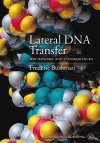 May 11:
May 11: Lateral DNA Transfer — Using the latest sequence information, the Salk Institute's Frederic Bushman examines the importance of transfer by all mechanisms. For those interested in the subject or barely aware of it, we recommend this new book. Selected quotes —
- Gene transfer between organisms takes place about 20 million billion times per second in the oceans (p 2).
- Lateral transfer is clearly an important source of genetic novelty in eukaryotes as well (p 4).
- Analysis of the draft sequence of the human genome reveals that is contains fully 8% endogenous retroviral sequences (p 204).
- [In mice] about 5% of [retroviral integrations] result in new phenotypes (p 205).
- Incorporation of retroviral sequences has contributed to the evolution of many vertebrate genes (p 206).
- Retroviruses have been incorporated into the genomes of all animals studied (p 209).
- The life history of retroviruses is ideally suited to generating evolutionary change in the organisms they infect (p 209).
 Lateral DNA Transfer: Mechanisms and Consequences, by Frederic Bushman, Cold Spring Harbor Laboratory Press, 2002 — 448 p / illus. / index / Paperback / $39 / ISBN 0-87969-621-4. Lateral DNA Transfer: Mechanisms and Consequences, by Frederic Bushman, Cold Spring Harbor Laboratory Press, 2002 — 448 p / illus. / index / Paperback / $39 / ISBN 0-87969-621-4.
 W. Ford Doolittle, "Thinking laterally about genes" (book review | link), p 589-590 v 418 Nature, 8 Aug 2002. W. Ford Doolittle, "Thinking laterally about genes" (book review | link), p 589-590 v 418 Nature, 8 Aug 2002.
 Viruses... is a related CA webpage. [Next-What'sNEW about HGT-Prev] Viruses... is a related CA webpage. [Next-What'sNEW about HGT-Prev]
 May 9, 2002:
May 9, 2002: Bet on sustainable evolutionary progress? On a new website, your correspondent has posted a prediction relevant to sustainable evolutionary progress in closed systems. The prediction will become a wager if someone takes the opposing side. Then, in the year 2020, the winnings will go to the charitable organization designated by the winner. [Thanks, Bruce Damer.]
 Long Bets homepage. Uncompleted bets are called Predictions. Ours is
#44. Long Bets homepage. Uncompleted bets are called Predictions. Ours is
#44.
 No instant winners at Longbets.org, by Andy Jordan, CNN.com, 31 May 2002. No instant winners at Longbets.org, by Andy Jordan, CNN.com, 31 May 2002.
 ...Is Evolutionary Progress ...Possible? is a related CA webpage. ...Is Evolutionary Progress ...Possible? is a related CA webpage.
 The Evolution Prize is a related local webpage, posted Jun 2006. The Evolution Prize is a related local webpage, posted Jun 2006.
 01 Jan 2020: The prediction is upheld. It reads:
By 2020, in real or artificial life, sustainable evolutionary progress in a genetically closed system will not have been demonstrated. 01 Jan 2020: The prediction is upheld. It reads:
By 2020, in real or artificial life, sustainable evolutionary progress in a genetically closed system will not have been demonstrated.
|

April 27: "Human endogenous retroviruses (HERVs), which are remnants of past retroviral infections of the germline cells of our ancestors, make up as much as 8% of the human genome and may even outnumber genes. Most HERVs seem to have entered the genome between 10 and 50 million years ago, and they comprise over 200 distinct groups and subgroups. ...Here we show, by phylogenetic and sequence analysis, that at least 16% of these [HERV-K (HML-2)] elements have undergone apparent rearrangements that may have resulted in large-scale deletions, duplications and chromosome reshuffling during the evolution of the human genome." These events played an important role in primate evolution, according to geneticists from Tufts University School of Medicine. [Thanks, Stan Franklin.]
 Jennifer F. Hughes and John M. Coffin, "Evidence for genomic rearrangements mediated by human endogenous retroviruses during primate evolution" [abstract], doi:10.1038/ng775, p 487-489 v 29 n 4 Nature Genetics, Dec (online 12 November) 2001. Jennifer F. Hughes and John M. Coffin, "Evidence for genomic rearrangements mediated by human endogenous retroviruses during primate evolution" [abstract], doi:10.1038/ng775, p 487-489 v 29 n 4 Nature Genetics, Dec (online 12 November) 2001.
 Viruses... is a related CA webpage. [Next-What'sNEW about HGT-Prev] Viruses... is a related CA webpage. [Next-What'sNEW about HGT-Prev]
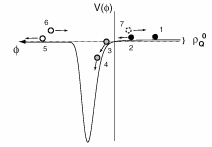 April 27:
April 27: Could the universe have always existed? This is the implication of a new version of the big bang theory recently published by Science. In the Introduction to the article cosmologists Paul Steinhardt of Princeton University and Neil Turok of the Center for Mathematical Sciences, Cambridge, write, "...We present a cosmological model with an endless sequence of cycles of expansion and contraction. By definition, there is neither a beginning nor end of time, nor is there a need to define initial conditions. In addition, we explain the role of dark matter and generate the homogeneity, flatness, and density fluctuations without invoking inflation." Of course the theory is neither proven nor widely accepted. But it shows that the standard big bang theory lacks the authority to overrule the hypothesis that life could come from the eternal past. "It appears that we now have two disparate possibilities: a univese with a definite beginning and a universe that is made and remade forever." [Thanks, Larry Klaes.]
 Paul J. Steinhardt and Neil Turok, "A Cyclic Model of the Universe" [abstract], p 1436-1439 v 296 Science, 24 May 2002. Published online by Science Express, 25 April 2002. Paul J. Steinhardt and Neil Turok, "A Cyclic Model of the Universe" [abstract], p 1436-1439 v 296 Science, 24 May 2002. Published online by Science Express, 25 April 2002.
 New Theory Provides Alternative to Big Bang, Princeton University, 25 April 2002. New Theory Provides Alternative to Big Bang, Princeton University, 25 April 2002.
 Big Bang alternative proposed, spacetoday.net, 26 April 2002. Big Bang alternative proposed, spacetoday.net, 26 April 2002.
 Big bangs spark row, by Tom Clarke, nature: scienceupdate, 26 April 2002. Big bangs spark row, by Tom Clarke, nature: scienceupdate, 26 April 2002.
 Before the big bang, by Edie Lau, Sacramento Bee, 27 April 2002. Before the big bang, by Edie Lau, Sacramento Bee, 27 April 2002.
 A Cyclic Universe? by Alan M. MacRobert, Sky and Telescope, 2 May 2002. A Cyclic Universe? by Alan M. MacRobert, Sky and Telescope, 2 May 2002.
 Evolution vs Creationism is a CA webpage that discusses the big bang. Evolution vs Creationism is a CA webpage that discusses the big bang.
 The End and the Big Bang is a related CA webpage. The End and the Big Bang is a related CA webpage.
 Gabriel Manzotti notes that alternative theories already existed, 1 May 2002. Gabriel Manzotti notes that alternative theories already existed, 1 May 2002.
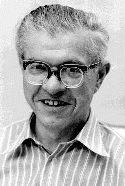 April 6:
April 6: Fred Hoyle's Universe is the theme of a conference at Cardiff University, Wales, 24-26 June 2002, hosted by Chandra Wickramasinghe, Geoffrey Burbidge and Jayant Narlikar. The session categories include Stars and Nucleosynthesis, Cosmology, Interstellar Matter, and Astrobiology.
 Fred Hoyle's Universe: Proceedings of a Conference, 25-26 June 2002, Cardiff University, UK, N.C. Wickramasinghe, Geoffrey Burbidge, J.V. Narlikar, eds., Springer, 2003. Fred Hoyle's Universe: Proceedings of a Conference, 25-26 June 2002, Cardiff University, UK, N.C. Wickramasinghe, Geoffrey Burbidge, J.V. Narlikar, eds., Springer, 2003.
 Fred Hoyle is a related CA webpage. Fred Hoyle is a related CA webpage.

|
 June 6:
Two New Astrobiology Journals —
June 6:
Two New Astrobiology Journals —



 May 19:
May 19: May 14:
May 14: May 11:
May 11:

 April 6:
April 6: